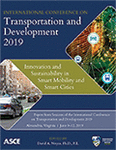International Conference on Transportation and Development 2019
Exploring the Application of LiDAR for Flooded Roadway Management
Publication: International Conference on Transportation and Development 2019: Innovation and Sustainability in Smart Mobility and Smart Cities
ABSTRACT
Flooding that results from severe storms and hurricanes has a major impact on infrastructure, roadway network operations, and safety in the United States (U.S.). Increases in impervious area and climate change contribute to the rising impact of hydrologic events. These occurrences can be extremely disruptive and costly, often accelerating the deterioration of the infrastructure they impact. These impacts can be mitigated if the proper tools are in place to assess flood extent and the damage caused by flooding. Unmanned aerial systems (UAS) equipped with light detection and ranging (LiDAR) equipment may present an opportunity to effectively perform these large spatial assessments in a more timely and precise manner than current practices (e.g. visual inspection). However, the limitations of LiDAR technology in this application are not well-known and require further research. This study aims to investigate LiDAR data precision level by varying the targeted standing water depth and LiDAR location height. Results of this study are expected to lay the groundwork for further analysis of the potential for the use of UAS-based LiDAR systems in scanning and mapping standing water on roadways.
Get full access to this chapter
View all available purchase options and get full access to this chapter.
REFERENCES
American Association of State Highway and Transportation Officials (AASHTO) (2018). “35 State DOTs are Deploying Drones to Save Lives, Time and Money”. Washington, D.C.
American Society of Mechanical Engineers (ASME). (2018). “A New Era in Robotic Infrastructure Inspections.”
Bemis, S. P., Micklethwaite, S., Turner, D., James, M. R., Akciz, S., Thiele, S. T., and Bangash, H. A. (2014). “Ground-based and UAV-Based photogrammetry: A multi-scale, high-resolution mapping tool for structural geology and paleoseismology.” Journal of Structural Geology, 69, 163–178.
Bizjak, D. K. F. (2010). “P2R2C2 Soil wetting-drying study.” Road Era, Report Nr-4.
Carrera, A., Dawson, A., Steger, J. (2009). “State of the art of materials’ sensitivity to Moisture change”. Road Era, Report Nr-2.
Christiansen, M., Laursen, M., Jørgensen, R., Skovsen, S., and Gislum, R. (2017). “Designing and Testing a UAV Mapping System for Agricultural Field Surveying.” Sensors, 17(12), 2703.
Cook, S. J., Clover, A., Brooks, C., Dobson, R., Banach, D., Oommen, T., Zhang, K., Mukherjee, A., Havens, T., Abhorn, T., Escobar-Wolf, R., Bhat, C., Zhao, S., Lyu, Q., Marion, N. (2018). “Implementation of Unmanned Aerial Vehicles (UAVs) for Assessment of Transportation Infrastructure – Phase II.” Michigan Department of Transportation, Michigan. Michigan Tech Research Institute, Michigan. Michigan Technological University, Michigan.
Elaksher, A. F., Bhandari, S., Carreon-Limones, C. A., Lauf, R. (2017). “Potential of UAV LiDAR Systems for Geospatial Mapping”. Cal Poly Ponoma University, California.
Federal Emergency Management Agency (FEMA). (2018). “Public Assistance Program and Policy Guide”. 129-130.
Federal Highway Administration (FHWA). (2013). “Emergency Relief Manual (Federal-Aid Highways)”. https://www.fhwa.dot.gov/reports/erm/er.pdf
Federal Highway Administration (FHWA). “Unmanned Aerial Systems (UAS) [PowerPoint Presentation].” https://www.fhwa.dot.gov/uas/(September 25, 2018).
Federal Highway Administration (FHWA). (2019). “Unmanned Aerial Systems (UAS).” https://www.fhwa.dot.gov/innovation/everydaycounts/edc_5/uas.cfm
Federal Highway Administration (FHWA). (2019). “Collaborative Hydraulics: Advancing to the Next Generation of Engineering (CHANGE).” https://www.fhwa.dot.gov/innovation/everydaycounts/edc_5/change2.cfm
Fewtrell, T. J., Duncan, A., Sampson, C. C., Neal, J. C., Bates, P. D. (2011). “Benchmarking urban flood models of varying complexity and scale using high resolution terrestrial LiDAR data.” Physics and Chemistry of the Earth, Parts A/B/C, 36(7-8), 281-291. https://doi.org/10.1016/j.pce.2010.12.011
Hokuyo. “URG-04LX-UG01.” <https://www.hokuyo-usa.com/products/scanning-laser-rangefinders/urg-04lx-ug01> (September 17, 2018).
Holguin-Veras, Jose. (2017). “Remote Sensing Decision Support System for Optimal Access Restoration in Post Disaster Environments.” Rensselaer Polytechnic Institute, New York. Rochester Institute of Technology, New York. New York City Department of Transportation, New York.
Irish, J. L. and White, T.E. (1998). “Coastal engineering applications of high resolution lidar bathymetry.” Coastal Engineering, 35(1-2), 47-51. https://doi.org/10.1016/S0378-3839(98)00022-2
Lercel, D., Steckel, R., and Pestka, J. (2018). “Unmanned Aircraft Systems: An Overview of Strategies and Opportunities for Missouri.” Missouri Department of Transportation, Missouri.
Lovelace, B., and Wells, J. (2018). “Improving the Quality of Bridge Inspections Using Unmanned Aircraft Systems (UAS).” Minnesota Department of Transportation, Minnesota.
Moving Ahead for Progress in the 21st Century (MAP-21). (2012). §52003; 23 USC 50.
Olsen, M. J., Roe, G. V., Glennie, C., Persi, F., Consulting, P., Reedy, M., Evans, D., Hurwitz, D., Williams, K., Tuss, H., Squellati, A., Evans, D., and Knodler, M. (2013). “NCHRP 15-44 Guidelines For The Use Of Mobile LiDAR In Transportation Applications.” National Cooperative Highway Research Program (NCHRP), National Research Council, Washington, D.C.
Skianis, G. A., Vaiopoulos, D., & Evelpidou, N. (2008). “Assessing the Ability of Airborne LiDAR to Map River Bathymetry.” Earth Surf. Process. Landforms, 33, 773 – 783. https://doi.org/10.1002/esp
Slamtec. “RPLIDAR A2.” <https://www.slamtec.com/en/Lidar/A2> (September 17, 2018).
Thodesen, C., and Hoff, I. (2010). “P2R2C2 Study of Water Effects on Asphalt and Porous Asphalt.” Road Era, Report Nr-5.
Velodyne LiDAR. “Puck LITE.” <https://velodynelidar.com/vlp-16-lite.html> (September 17, 2018).
Williams, K., Olsen, M., Roe, G., and Glennie, C. (2013). “Synthesis of Transportation Applications of Mobile LIDAR.” Remote Sensing, 5(9), 4652-4692.
Information & Authors
Information
Published In
International Conference on Transportation and Development 2019: Innovation and Sustainability in Smart Mobility and Smart Cities
Pages: 36 - 45
Editor: David A. Noyce, Ph.D., University of Wisconsin–Madison
ISBN (Online): 978-0-7844-8258-2
Copyright
© 2019 American Society of Civil Engineers.
History
Published online: Aug 28, 2019
Authors
Metrics & Citations
Metrics
Citations
Download citation
If you have the appropriate software installed, you can download article citation data to the citation manager of your choice. Simply select your manager software from the list below and click Download.
